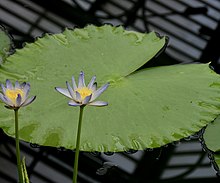| Nymphaea macrosperma | |
|---|---|

| |
| Conservation status | |
| Special Least Concern (NCA) | |
| Scientific classification | |
| Kingdom: | Plantae |
| Clade: | Tracheophytes |
| Clade: | Angiosperms |
| Order: | Nymphaeales |
| Family: | Nymphaeaceae |
| Genus: | Nymphaea |
| Subgenus: | Nymphaea subg. Anecphya |
| Species: | N. macrosperma |
| Binomial name | |
| Nymphaea macrosperma Merr. & L.M.Perry | |
| Synonyms | |
| |
Nymphaea macrosperma is an annual or perennial, aquatic, rhizomatous herb in the family Nymphaeaceae native to Australia and New Guinea.
Description
Vegetative characteristics
It is an annual or perennial, aquatic, rhizomatous herb with globular rhizomes without stolons. The glabrous, orbicular, elliptic or suborbicular leaves with a dentate margin are 17–38 cm long, and 15–31 cm wide. The abaxial leaf surface has a strong midrib and 6 palmately arranged primary veins, which are reticulate towards the leaf margin. The petioles are up to 2.5 m long, and 2-4 mm wide.
Generative characteristics
The 6–7 cm wide, diurnal flowers extend above the water surface. The four oblong sepals with a rounded apex are 25-55 mm long, and 9-25 mm wide. The 10–18(–22) white, blue, or purple, oblanceolate to spathulate petals have an obtuse apex. There is a conspicuous gap between petals and stamens. The androecium consists of 150–200 stamens. The gynoecium consists of 10–13 carpels. The 4 cm wide fruit bears oblong to ovoid, hairy, 3–4.5 mm long, and 2–3 mm wide seeds.
Taxonomy
Publication
It was published by Elmer Drew Merrill and Lily May Perry in 1942. In the same publication, the species was described a second time as Nymphaea dictyophlebia Merr. & L.M.Perry, which is a synonym of Nymphaea macrosperma Merr. & L.M.Perry.
Type specimen
The type specimen was collected by LJ Brass in Lake Daviumbu, New Guinea (British New Guinea) in August 1936.
Position within Nymphaea
It is placed in Nymphaea subgenus Anecphya.
Etymology
The specific epithet macrosperma means large-seeded.
Ecology
Habitat
It occurs in up to 2.5 m deep stagnant or flowing water in lagoons, swamps, billabongs, and drainage channels on clay substrates. It can occur in slightly brackish water.
Conservation
The NCA status of Nymphaea macrosperma is Special Least Concern (SL). Under the Biodiversity Conservation Act 2016, it is classified as Not threatend.
Uses
The plant is a traditional Aboriginal bushfood. The seeds are usually described as "sweet like a pea" and are eaten for lunch.
References
- ^ Queensland Government. (2022i, March 8). Species profile—Nymphaea macrosperma. Retrieved February 1, 2024, from https://apps.des.qld.gov.au/species-search/details/?id=13387
- ^ "Nymphaea macrosperma Merr. & L.M.Perry". Plants of the World Online. Royal Botanic Gardens, Kew. Retrieved 11 January 2024.
- ^ Western Australian Herbarium & Department of Biodiversity, Conservation and Attractions. (n.d.-b). Nymphaea macrosperma Merr. & L.M.Perry. Florabase—the Western Australian Flora. Retrieved December 2, 2024, from https://florabase.dbca.wa.gov.au/browse/profile/19830
- Missouri Botanical Garden. (n.d.-f). Nymphaea macrosperma Merr. & L.M. Perry. Tropicos. Retrieved December 2, 2024, from http://legacy.tropicos.org/Name/50265123
- ^ Northern Territory Government. (n.d.). Nymphaea macrosperma Merr. & L.M.Perry. FloraNT. Retrieved December 2, 2024, from https://eflora.nt.gov.au/factsheet?id=3999
- ^ S.W.L. Jacobs & C.L. Porter. Nymphaea macrosperma, in (ed.), Flora of Australia. Australian Biological Resources Study, Department of Climate Change, Energy, the Environment and Water: Canberra. https://profiles.ala.org.au/opus/foa/profile/Nymphaea%20macrosperma
- ^ Merrill, Elmer D., & Perry, Lily M. (1942). Plantae Papuanae Archboldianae, X. Journal of the Arnold Arboretum, 23(4), 383--416. https://doi.org/10.5962/p.185463
- ^ Breukel, H. (n.d.). Nymphaea macrosperma Merr. & L.M. Perry. Seerosenforum.de Das Portal Der Seerose. Retrieved February 1, 2024, from https://www.seerosenforum.de/gattung/Anecphya/Macrosperma/Macrosperma.aspx
- Jacobs, S. W. L. (1992). "New species, lectotypes and synonyms of Australasian Nymphaea (Nymphaeaceae)." Telopea, 4(4), 635-641.
- Type of Nymphaea macrosperma Merr. & L.M.Perry . (n.d.). JSTOR. Retrieved February 1, 2024, from https://plants.jstor.org/stable/10.5555/al.ap.specimen.l0038664
- Löhne, C., Borsch, T., Jacobs, S. W., Hellquist, C. B., & Wiersema, J. H. (2008). "Nuclear and plastid DNA sequences reveal complex reticulate patterns in Australian water-lilies (Nymphaea subgenus Anecphya, Nymphaeaceae)." Australian Systematic Botany, 21(4), 229-250.
- Crataegus macrosperma (large-seeded hawthorn): Go Botany. (n.d.). Native Plant Trust. Retrieved February 1, 2024, from https://gobotany.nativeplanttrust.org/species/crataegus/macrosperma/
- Bayton, R. (2020). Practical Uses of Botanical Latin. In The Gardener's Botanical: An Encyclopedia of Latin Plant Names - with More than 5,000 Entries (pp. 22-318). Princeton: Princeton University Press. https://doi.org/10.1515/9780691209135-007
- Australian Food Standards, Water lily seed pod analysis
- "Part 1". In the Bush with Malcolm Douglas. Season 1. 7 February 2009.
| Taxon identifiers | |
|---|---|
| Nymphaea macrosperma |
|
| Nymphaea dictyophlebia | |
This Australian plant article is a stub. You can help Misplaced Pages by expanding it. |